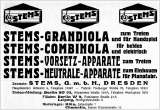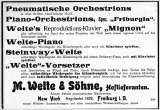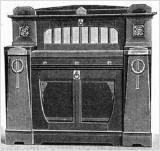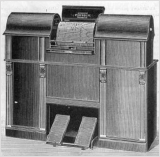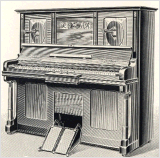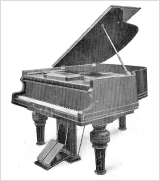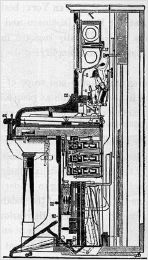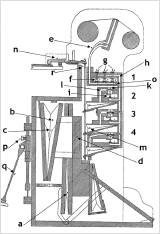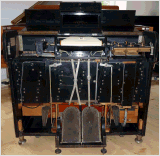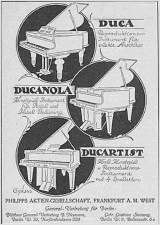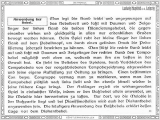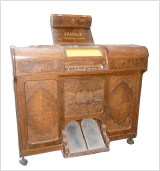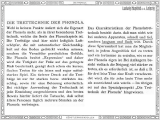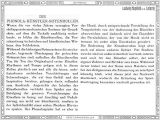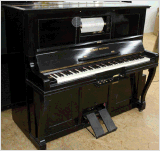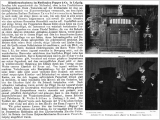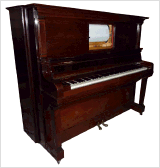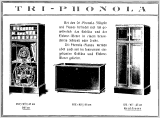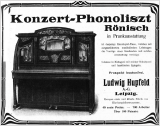„Pianola“ instruments have been offered in a large variety of different designs - technically as well as cabinet-wise. Customer demands, competitor moves as well as technical and patent issues fostered a wide portfolio of different types of "Pianolas". The basic principles of a player piano are more or less the same.
To differentiate between the types of a player piano, here are some characteristics:
Version (Cabinet, push-up player, built-in piano and/or built-in grand piano)
Design (Pedal-Piano, Artistic Piano, Reproducing Piano)
Scale (number of holes at the tracker bar) and
Style (varies by manufacturer: Aeolian, Hupfeld, Welte, Philipps, etc.)
The following overview shall help to understand some basics of this interesting "world of pianolas". There are extensive books, webpages etc. around this topic - please ask for recommendations in case you want to learn more. Additions, corrections, remarks are very welcome.
Four Pianola Versions
Basically, four different versions are found:
Cabinet
Push-up player
Pianola piano
Pianola grand piano
Cabinet player
Cabinets are those pianola systems called that merge the self-playing system with an acoustic piano in one case but lack a keyboard. In these systems, the self-playing system accesses the action of the piano directly. It is a reproduction system that replays the music automatically and accentuated. These systems were most suitable for music lovers who wanted to listen to music from piano rolls without playing the instrument themselves. Cabinets were produced by M. Welte & Soehne (Freiburg) on a large scale using Feurich and Steinway pianos inside. These cabinets have become rare today. The one -and to our knowledge only- DUCA cabinet by Philipps is in our collection as well.
Push-up player
The push-up players were the first systems made in great number. Pianola by the Aeolian Company and Phonola by Hupfeld AG are very well known examples. A push-up player is pushed in front of a manual (grand) piano. The self-playing system is integrated into the push-up player. The push-up player has 65-88 fingers that touch down on the keys and thus play the music, read from the piano roll, on the keyboard. Push-up players are interesting if you like to enjoy the sound of an already available (grand) piano - or would like to use the push-up player at different instruments. Push-up players are available as pedal Pianola to perform the accentuation and expression by the Pianolist as well as reproducing systems (i.e. Welte-Mignon) to play fully automatically.
Pianola Piano
The manufacturers of self-playing mechanisms soon realized that more and more customers found the setup of push-up players cumbersome, because they did not only need to be pushed at the instrument but also had to be properly adjusted to height, pedal position and accentuation. Moreover, people less and less wanted to have this additional piece of furniture in their living rooms. Attractive additional income opened up for the manufacturers of self-playing mechanisms when they sold combined instruments. So it was not long until manufacturers like Aeolian or Hupfeld cooperated with many well-known (grand) piano manufacturers - or took them over later - and offered mainly pianola pianos.
Pianola grand piano
Pianola systems became increasingly inserted into (grand) pianos after 1908. When the pianola system was integrated into the instrument, the latter could be used both as a manual instrument and as a pianola. As for pianola grands, it turned out fast that many customers found the receptacles of the foot pedals were looking too clumsy and operation of the often shortened conventional soft pedals was less than ideal. The later electrically driven pianola grands did not require these components anymore because the suction was fed by the motor.
Combined instruments
The suppliers were very inventive in marketing these combined instruments. Since many households already owned conventional manual (grand) pianos, the customers had to be persuaded to switch. Repurchase actions and free rolls were offered, among other things.
Besides these main versions, there was a huge number of other creative self-playing solutions that did not prevail. Thus there were low-mount devices for grands, keyboard attachment devices for pianos etc.
Basic construction of a pianola
The basic system of all pianolas is the same: see an exemplary representation in the cross section to the right. Concisely said: Foot pedals or electrically driven suction fans help to generate low pressure in the isolated self-playing mechanism. An unwinding and a take-up reel unwind the punched paper of a piano roll across the tracker bar, so that the holes release each desired tone in the tracker bar. There is one bellow for each tone, to generate it in the mechanism (by the key, for push-up players), this bellow is sucked empty by the control and folds up. Once the hole in the tracker bar is again covered by paper, the bellows open again. There are different solutions for how the bellows are controlled. Instruments with, for example, automatic accentuation, pedal, automatic shutdown and rewind apply holes in the tracker bar for all these functions, realizing each of them by suitable pneumatic arrangements. Alternatively, operating levers at the pianola may serve according to the information on the piano roll or the taste of the pianolist. Almost all pianolas that were built later than 1902 had their wind chests divided near the center of the keyboard into bass and descant to control them individually.
Principles of the Hupfeld Phonola Push-up Player
An excellent explanation is enclosed in the "Phonola Spiel- und Regulier-Anleitung mit Konstruktionszeichnung" pamphlet that the buyers of the Phonola received after 1902. The following description and the adjacent sketch are quoted here from an original source. Below the sketch is a side view of a contemporary push-up player.
Hupfeld Phonola description
“If a sheet of music is laid over the scale bar [= tracker bar] and the pedal mechanism is set in motion, the feeders a empty the reservoirs b in which the springs c are located. At the same time, the wind tunnel d and the channels 1, 2, 3, 4 are sucked vacuous; the latter four channels contain the pouches and the valves which are in rest until an opening in the sheet of music permits the ambient air to enter by an opening of the scale block. The brass pipes e serve to conduct the air from the scale block to the pouches. Now the small pouch f is lifted by the entering air, as is the small valve g which locks below but admits above a second entry of ambient air via the opening generated there into a ventilation shaft h that leads to the pouch i. The latter is lifted and rests the valve k at the top to prevent outside air from entering. At this moment, the ventilation shaft l and the bellows m are subject to the suction, causing the bellows to be spontaneously pulled to press the finger n down onto the piano keys. As soon as the opening in the scale block is closed again, all parts return into their original position, while the pouch f vents the ambient air by the small bleed o.” p and q are mentioned in the regulation instructions as addressing the pedal." p und q sind in der Regulierungsanleitung erwähnt, da diese das Pedal bedienen.
Three pianola designs
Three main designs are distinguishable:
the pedal instrument
the artistic instrument
the reproduction instrument
All three designs were available in aforementioned four types - and merged into one instrument (p. e. the Hupfeld Triphonola or Welte-Mingon combined). The cabinets are an exception, because these were designed as reproduction instruments. Pure pedal instruments began to vanish after 1910 and were replaced by artistic instruments. The designs differ in the way different piano rolls are reproduced.
The pedal instrument
… is the simplest and early form of the standard pianola. The self-playing mechanism for playing back the piano rolls is driven by treading the pedals. In the beginning, the piano roll contained only the punches adopted from the sheet of music for the notes but no punchings for accentuation, tempo, dynamism. Adding accentuation and expression to the music was the task of the pianolist, i.e. the person sitting at the pianola. Hupfeld wrote specifically about the handling of the levers in one of its instructions (see accompanying picture).
Principles of a pedal instrument
The pedals serve to control the dynamism (volume), because the music is soft when the pedal is slightly treaded but loud when it is powerfully treaded. The operating levers help to control the accentuation which meant in the early pianolas only an increase of the descant or the bass half and the tempo. Among the pictures further down in the gallery, the second picture shows the lever for tempo control - below that are two levers to accentuate descant and bass. The descant is here in the basic position on "Forte" and can be guided to "piano" by reducing air feed. The bass is vice versa on "piano" and can be guided to "forte". In this example, the right pedal can be operated by the button that applies powerful bellows to move a linkage pressing the pedal inside the instrument down. In the last but one picture, you see the rotary knob (otherwise often designed as a lever) that sets the flow of the roll on "Retour" to rewind it after the roll has ended. The last picture shows the inscription of a drawn Hupfeld Phonola piano roll.
Principles of a pedal instrument
| Klicken Sie hier, um zur Galerie zu gelangen. |
A pedal player not really a self-playing one
“Self-playing” instrument is only within limits the correct term for this design of the pedal piano. The tones may be played according to the piano roll in the proper order and composition - but the pianolist has to shape them into a melodious and possibly nicely interpreted piece of music, because he controls tempo, dynamism and accentuation. Many piano rolls include additional information about that, so that the pianolist can control dynamism and accentuation the way the piano roll manufacturer intended it for this piece. The treading technique is essential for the sound of music made on this pianola design. There is as well an interesting specification by Hupfeld - shown on the adjacent image.
Rising demand of customers
The demand from these pedal instruments increased very quickly, and the customers wanted music that would sound less mechanical and lifeless. Thus, “artist's rolls” were launched to the market in 1907 - the tones of music are here arranged on the piano roll the way a certain pianist played this piece - the first “recordings” were made. Pedal operation (right pedal) and accentuation were then already indicated on the piano roll and guided by punchings. Before the standardization, any manufacturer had a specific way for that. The generation of dynamism and accentuation were still incumbent upon the pianolist, however, so that he would either follow the dynamism and accentuation orders given on the roll as a reproducing pianist or apply his own interpretation. Artistic instruments were launched to the market to play back these artist's rolls. When they were introduced in 1907, Hupfeld wrote in its pamphlet the accompanying text about the meaning of this new form of piano rolls.
The artistic player piano
… is thus a design that complements the pedal piano with additional functions, such as automatic accentuation, that usually was individually named by the manufacturer, for example as:
"Solodant" for Hupfeld
"Themodist" for Aeolian
"Melodant" for Angelus etc.
and pedal function (sustain pedal = right pedal) that could as well be automatically addressed by suitable punchings on the piano rolls. There are levers near the piano roll box to switch accentuation and pedal function on or off, in addition to the levers of the pedal piano (see examples in the gallery). These functions are specific for the manufacturer, because their realization and the arrangement of the punchings on the rolls was often individual. Flawless function of the melody and pedal control will therefore mostly require piano rolls by the manufacturer. Additional control of dynamism and accentuation was again permitted by the levers right in front of the keyboard. The pianolist could thus perform the piece very exactly. There are recordings on which a piece is reproduced by very experienced pianolists at the artistic piano - and only experts will perceive the difference to manual play.
Solodant Themodist Melodant
| Klicken Sie hier, um zur Galerie zu gelangen. |
Artistic player pianos of Hupfeld etc.
Artistic pianos became the dominating mode of pianolas after 1908. The quality of equipment and implementation could vary with each manufacturer. In the gallery you may watch an example of an Aeolian artistic piano with a transposing device at the tracker bar. Hupfeld dominated the German market. Artistic pianos originally provided predominantly a foot pedal mode - later, however, electric fan systems that had automatic shutdown, rewind, some had a repeat function and a few, also basic accentuation functions.
Examples of manufacturer names of artistic instruments are:
Solo Phonola by Hupfeld
Themodist by Aeolian
Ducanola by Philipps
Estrella by Popper etc...
The reproducing instrument
… was introduced by M. Welte & Sons from Freiburg in 1904. Mr. Welte and Mr. Bockisch focused on recording the play of a pianist in all detail and on reproducing it with a suitable device. One of Welte's brochures says, “Any mechanical music, however carefully edited, will always sound mechanical, it lacks freedom in motion, a natural flow, variety of perception, the often insignificant and yet lovely changes of tempo. Briefly, the play lacks what would make it 'artistic' or 'perfect'. After extended study we found that the only solution that would thoroughly remove all the mentioned imperfections is the recording of the pianist himself and its reproduction on a grand or a piano.”
The Welte cabinet was released in 1904, and it was the first reproducing piano of this quality. The recording modes are more thoroughly discussed in the chapter "Piano Rolls". The Zeitschrift für Instrumentenbau reports on occasion of the fair before Easter in 1905 about this new invention with amazement (see accompanying excerpt).
Special piano rolls for reproducers
The special piano rolls for reproduction instruments contain all information for a fully automated reproduction of the piece. Control of the reproduction by the pianolist is neither intended nor possible, unlike at the artistic piano. The realization of any high quality of reproduction was individually achieved by the manufacturers. From this follows that reproductive piano rolls will operate and unfold the intended quality only on the instruments of the respective manufacturers. The reproduction instruments play 80-88 tones and have, in addition, 10-20 holes in the tracker bar for controlling. You may find further details on these instruments and the piano rolls on these pages in the respective sections. Of course, those piano roll recordings that represent unique audio documents are most interesting - as in the cases of Edvard Grieg or Alfred Reisenauer, who had died before 1907, of course.
Reproducing pianos
| Klicken Sie hier, um zur Galerie zu gelangen. |
Some examples of reproducing pianos
Examples of reproduction instruments are:
World-Mignon red (T100) from 1904
Hupfeld DEA (from 1907)
Philipps Duca (from 1908)
Aeolian Duo-Art (from 1913)
Ampico A from 1918
Hupfeld Triphonola (from 1919)
World-Mignon green (T98) from 1924
Ampico B from 1929
In addition, there were other reproduction instruments, such as Hugo Poppers' Stella, that never achieved any appreciable market share. Almost no reproducing rolls for those have survived. In the book "Re-Enacting the Artist", Larry Givens writes about the Ampico B system, "With its fewer moving parts, its electric roll drive mechanism, its quieter pump and exhaust, its rapid-acting valves, and many other improvements and innovations the Model B Ampico cannot be considered anything less than the zenith of player piano development."
External fans or suction pumps
All reproduction instruments were equipped with electric fans - integrated into the instruments, as external fans in a unit or chest or as a main supply in a separate room. Reproduction systems were designed as push-up players, cabinets without keyboards or integrated into (grand) pianos. Some reproduction systems could also be used as artistic pianos. The prefix "Duo" in Duo-Art or "Tri" of the Triphonola point that out. The Triphonola merges three different uses into one instrument, for example.
Of course there were many other designs for how to operate a piano as one out of several self-playing instruments - we will not discuss these "orchestrions" here.
Styles of pianolas
Of course the different manufacturers tried to design their instruments so that they could achieve more turnover than the competition. This is evident from the arrangement of the self-playing system or from the design of the pianola cases. The styling was adapted to different groups of buyers, markets or the prevailing taste. Instruments for private households had a different shape than instruments for use in café houses or restaurants. The technical conversion of the self-playing mechanisms - though founded on the same basic principles - is differently realized by each manufacturer and may often vary even among the different systems by the same manufacturer. Reproduction instruments were often inserted into extremely sophisticated cases, sometimes according to an artist's drafts or individually, according to the customer's furniture.
Pianola styles
| Klicken Sie hier, um zur Galerie zu gelangen. |

